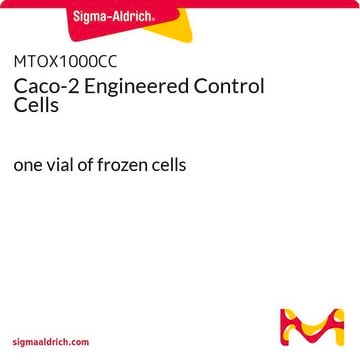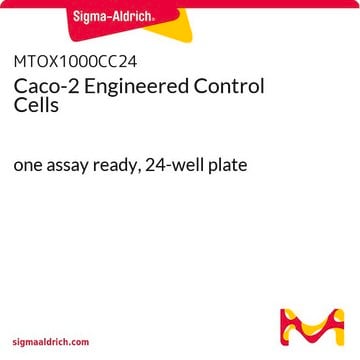推荐产品
产品名称
MRP4 Knockout Caco-2 Cells, one assay ready, 24 well plate
生物来源
human colon
表单
liquid
形态学
Epthelial
技术
drug transporter assay: suitable
permeability assay: suitable
应用
ADME/TOX
正在寻找类似产品? 访问 产品对比指南
一般描述
The C2BBe1 cells, a subclone of Caco-2 cells, correspond to ATCC Cat. No. CRL-2102. The MRP4 knockout C2BBe1 cells are adenocarcinoma, epithelial cells from a human caucasian male (aged 72 years) with functional knockout of the MRP4 efflux transporter.
The three week production lead time begins on the Monday following a purchase, in the third week the cells are shipped overnight for receipt on Tuesday or Wednesday. As a biologic product that′s shipped at room temperature the cells must be processed immediately upon receipt.
The three week production lead time begins on the Monday following a purchase, in the third week the cells are shipped overnight for receipt on Tuesday or Wednesday. As a biologic product that′s shipped at room temperature the cells must be processed immediately upon receipt.
应用
The following posters and articles demonstrate how Caco-2 cells can be used for cell based assays:
Transporter Function in Caco-2 Cells with Targeted P-Glycoprotein, MRP2 and BCRP Gene Knockout Using Zinc Finger Nucleases
Comparison of Function and Relative Transporter Protein Concentrations in Caco-2 Cells with Single and Double Knockouts of the ABCB1, ABCG2, and ABCC2 Genes
Caco-2 Transporter Knockout Cell Based Assays
Transporter Function in Caco-2 Cells with Targeted P-Glycoprotein, MRP2 and BCRP Gene Knockout Using Zinc Finger Nucleases
Comparison of Function and Relative Transporter Protein Concentrations in Caco-2 Cells with Single and Double Knockouts of the ABCB1, ABCG2, and ABCC2 Genes
Caco-2 Transporter Knockout Cell Based Assays
特点和优势
The Caco-2 subclone, C2BBe1 cells, are ideal for transporter analysis as they express multiple transporters, are human derived and grow in a homogenous monolayer that forms tight juntions which is necessary for efflux ratio analysis. Other benefits include:
- A functional knockout of the MRP4 gene eliminates the reliance on chemical inhibitors to determine if a compound is an MRP4 substrate
- The 24 well Transwell format enables the MRP4 knockout cells to be included in standard drug transporter protocols
- Human assay with no interference from animal inhibitors
- Overcome the limitations of RNAi and knockdown cell lines that arise from remaining transporter functionality
- A functional knockout of the MRP4 gene eliminates the reliance on chemical inhibitors to determine if a compound is an MRP4 substrate
- The 24 well Transwell format enables the MRP4 knockout cells to be included in standard drug transporter protocols
- Human assay with no interference from animal inhibitors
- Overcome the limitations of RNAi and knockdown cell lines that arise from remaining transporter functionality
相关产品
产品编号
说明
价格
储存分类代码
12 - Non Combustible Liquids
WGK
WGK 3
闪点(°F)
Not applicable
闪点(°C)
Not applicable
P Artursson
Journal of pharmaceutical sciences, 79(6), 476-482 (1990-06-01)
A human intestinal cell line, Caco-2, was used as a model to study the passive diffusion of drugs across intestinal epithelium. The cells formed continuous monolayers when grown on permeable filters of polycarbonate. After 10 days in culture, the monolayers
X Wu et al.
Pharmaceutical research, 17(2), 209-215 (2000-04-06)
The purpose of this study was to elucidate the mechanisms by which an HMG-CoA reductase inhibitor, atorvastatin (an organic acid with a pKa of 4.46), was transported in the secretory and absorptive directions across Caco-2 cell monolayers. Caco-2 cells were
V Pade et al.
Journal of pharmaceutical sciences, 87(12), 1604-1607 (1999-04-03)
The objective of this investigation was to establish a relationship between drug permeability and solubility in vitro and the extent of drug absorption in humans. We selected drugs with varying permeabilities and solubilities with the aim of establishing a relationship
M J Briske-Anderson et al.
Proceedings of the Society for Experimental Biology and Medicine. Society for Experimental Biology and Medicine (New York, N.Y.), 214(3), 248-257 (1997-03-01)
The Caco-2 cell line is used by many investigators as a model of the intestinal epithelium to study nutrient uptake and transport. Our goal was to create an awareness of inherent variabilities in the Caco-2 cell line which may influence
Mark I Kaldas et al.
The Journal of pharmacy and pharmacology, 55(3), 307-312 (2003-05-02)
Resveratrol is a dietary constituent suggested to have protective effects against cancer as well as cardiovascular disease. The purpose of the study was to learn whether this agent could be absorbed in man and enter the systemic circulation. This was
商品
Application note on Drug transport assays in a 96-well system using Millicell-96 System from Millipore.
我们的科学家团队拥有各种研究领域经验,包括生命科学、材料科学、化学合成、色谱、分析及许多其他领域.
联系客户支持





